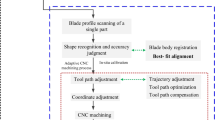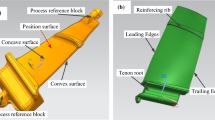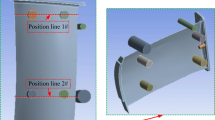Abstract
This study proposes an adaptive CNC machining process based on on-machine measurement to control the machining error of near-net-shaped blades. The multi-source and multi-process machining error transmission model of a near-net-shaped blade is established, and the reduction effect of the machining error transmission chain by the adaptive CNC machining process is qualitatively analyzed based on the machining error transmission flow model. The effects of the adaptive CNC machining process on the positioning benchmark error, machining position error, and machining contouring error are explored through the adaptive CNC machining process experiment. In particular, the ability of the adaptive CNC machining process to cooperatively control the blade position error and the contouring error is discussed in relation to the stiffness of the blade-fixture system. The results show that the adaptive CNC machining process can reasonably reduce the machining errors caused by the positioning benchmark. The final deviation band of the blade body is reduced by 60% based on the adaptive CNC machining process. The adaptive CNC machining process can optimize the contouring error and the position error of the blade tenon root under the enough premise of the stiffness of the blade-fixture system. The adaptive CNC machining process has the excellent ability to control machining errors to improve the machining quality of the blade.



























Similar content being viewed by others
Data availability
Not applicable.
References
Lin XJ, Wu DB, Yang BY, Wu G, Shan XF, Xiao QB, Hu L, Yu J (2017) Research on the mechanism of milling surface waviness formation in thin-walled blades. Int J Adv Manuf Technol 93:2459–2470
Wu D, Wang H, Zhang K, Zhao B (2020) Research on adaptive CNC machining arithmetic and process for near-net-shaped jet engine blade. J Intell Manuf 31:717–744
Wu D, Wang H, Yu J, Zhang K (2020) Machining fixture for adaptive CNC processing technology of near-net-shaped jet engine blade. Chin J Aeronaut 33:1311–1328
Budak E (2006) Analytical models for high performance milling. Part I: cutting forces, structural deformations and tolerance integrity. Int J Mach Tool Manu 46:1478–1488
Chen W, Ni L, Xue J (2008) Deformation control through fixture layout design and clamping force optimization. Int J Adv Manuf Technol 38:860–867
Padmanaban KP, Arulshri KP, Prabhakaran G (2009) Machining fixture layout design using ant colony algorithm based continuous optimization method. Int J Adv Manuf Technol 45:922–934
Khan AW, Wuyi C (2010) Systematic geometric error modeling for workspace volumetric calibration of a 5-axis turbine blade grinding machine. Chin J Aeronaut 23:604–615
Rong Y, Wei C, Fangyu P, Lin S, Bin L (2012) Closed-chain stiffness field modeling and stiffness performance analysis of multi-axis machining system [J]. Aust J Mech Eng 48(1):176–184
Diez E, Perez H, Marquez J, Vizan A (2015) Feasibility study of in-process compensation of deformations in flexible milling. Int J Adv Manuf Technol 94:1–14
Li Z-L, Tuysuz O, Zhu L-M, Altintas Y (2018) Surface form error prediction in five-axis flank milling of thin-walled parts [J]. Int J Mach Tools Manuf 128:21–32
Bolar G, Das A, Joshi SN (2018) Measurement and analysis of cutting force and product surface quality during end-milling of thin-wall components. Measurement 121:190–204
Zhang Z, Qi Y, Cheng Q, Liu Z, Tao Z, Cai L (2019) Machining accuracy reliability during the peripheral milling process of thin-walled components. Robot Comput Integr Manuf 59:222–234
Fountas NA, Kechagias J, Benhadj-Djilali R, Stergiou CI, Vaxevanidis NM (2014) "Optimizing 5-axis sculptured surface finish machining through design of experiments and neural networks." Proceedings of the ASME 12th Biennial Conference on Engineering Systems Design and Analysis. July 25–27, 2014. V001T06A002. ASME
Ma Y, Hong J, Min Y, Wang X (2004) Global optimization algorithm for machining and positioning of large-scale and complex surface-like blanks. Journal of System Simulation 17(4):825–826 830
Ghiea W, Laperriere L, Desrochers A (2010) Statistical tolerance analysis using the unified Jacobian–Torsor model [J]. Int J Prod Res 48(15):4609–4630
Feng J, Pingyu J, Daoyu L (2011) Zheng magnesium, Error transfer control method for blade batch processing. Comput Integr Manuf Syst 18(1):76–86
Hu SJ (1997) Stream of Variation theory for automotive body assembly. Annals of the CIRP 46(1):1–6
Ceglarek D, SHI J, WU S M. (1994) A Knowledge-based diagnosis approach for the launch of the auto-body assembly process [J]. ASME J Eng Ind 116(4):491–499
Ceglarek D, SHI J (1996) Fixture failure diagnosis for auto-body assembly using pattern recognition [J]. J Eng Ind 118:55–66
Guiassa R, Mayer R (2011) Predictive compliance based model for compensation in multi-pass milling by on-machine probing. CIRP Annals—Manufacturing Technology 60:391–394
Bandy HT, Donmez MA, Gilsinn DE, Han C, Kennedy M, Ling AV, Wilkin ND, Yee KW (2001) A Methodology for compensating errors detected by process-intermittent inspection. NIST Interagency/Internal Report (NISTIR) 6811, 1:–77
Yu J-H, Chen Z-T, Jiang Z-P (2016) A control process for machining distortion by using an adaptive dual-sphere fixture. Int J Adv Manuf Technol 86:9–12
Huang N, Yin C, Liang L, Hu J, Shijing W (2018) Error compensation for machining of large thin-walled part with sculptured surface based on on-machine measurement. Int J Adv Manuf Technol 96:4345–4352
Code availability
Not applicable.
Funding
This research was supported in part by Xi’an Aero-Engine (Group) Ltd. and the National Natural Science Foundation of China [grant number 51575310].
Author information
Authors and Affiliations
Contributions
Dongbo Wu: experiment, data analysis, original draft writing
Hui Wang: methodology, formal analysis, writing—review and editing
Jie Yu: experiment
Corresponding author
Ethics declarations
Ethics approval
Not applicable.
Consent to participate
Not applicable.
Consent for publication
Not applicable.
Competing interests
The authors declare no competing interests.
Additional information
Publisher’s note
Springer Nature remains neutral with regard to jurisdictional claims in published maps and institutional affiliations.
Rights and permissions
About this article
Cite this article
Wu, D., Wang, H. & Yu, J. Research on machining error transmission mechanism and compensation method for near-net-shaped jet engine blades CNC machining process. Int J Adv Manuf Technol 117, 2755–2773 (2021). https://doi.org/10.1007/s00170-021-07818-5
Received:
Accepted:
Published:
Issue Date:
DOI: https://doi.org/10.1007/s00170-021-07818-5




